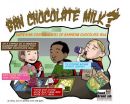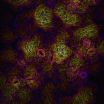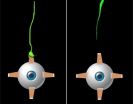(Press-News.org) VIDEO:
Director of the Cornell Food and Brand Lab, Brian Wansink recommends, "There are other ways to encourage kids to select white milk without banning the chocolate. Make white milk appear...
Click here for more information.
For many children eating school lunch, chocolate milk is a favorite choice. What would happen if chocolate milk were banned from school cafeterias? "Students take 10% less milk, waste 29% more and may even stop eating school meals," says Andrew Hanks, PhD.
In a recent article published in PLOS ONE, researchers for the Cornell Center for Behavioral Economics in Child Nutrition Programs (B.E.N. Center), reported results from data collected at 11 Oregon elementary schools where chocolate milk had been banned from the cafeterias and replaced with skim milk. While this policy eliminated the added sugar in chocolate milk, there were unexpected nutritional and economic backlashes.
The new Cornell Food and Brand Lab study by Andrew Hanks, David Just, and Brian Wansink, found that eliminating chocolate milk from the elementary schools decreased total milk sales by 10%, indicating that many students substituted white for chocolate milk. Even though more students were taking white milk, they wasted 29% more than before. Nutritionally, after the milk substitution, students on average consumed less sugar and fewer calories, but also consumed less protein and calcium. Additionally, the ban may have been a factor in a 7% decrease in District's Lunch Program participation.
Removing flavored milk from cafeterias decreases added sugar, yet the economic and nutritional costs warrant reconsidering a less restrictive policy. Nicole Zammit, former Assistance Director of Nutrition Services at Eugene School District, was not surprised that banning chocolate milk had negative consequences. She had this to say, "Given that the role of the federal school meal program is to provide nutritious meals to students who may otherwise have no access to healthy foods– I wouldn't recommend banning flavored milk unless you have a comprehensive plan in place to compensate for the lost nutrients when kids stop drinking milk altogether."
In conclusion, co-author and Director of the Cornell Food and Brand Lab, Brian Wansink recommends, "There are other ways to encourage kids to select white milk without banning the chocolate. Make white milk appear more convenient and more normal to select. Two quick and easy solutions are: Put the white milk in the front of the cooler and make sure that at least 1/3 to 1/2 of all the milk is white."
INFORMATION:
For more tips and ideas visit SmarterLunchrooms.org
The surprising consequences of banning chocolate milk
2014-04-17
ELSE PRESS RELEASES FROM THIS DATE:
Family ties in the language jungle
2014-04-17
This news release is available in German. The only linguistic data available for Carabayo, a language spoken by an indigenous group that lives in voluntary isolation, is a set of about 50 words. This list was compiled in 1969 during a brief encounter with one Carabayo family. Frank Seifart of the Max Planck Institute for Evolutionary Anthropology in Leipzig, Germany, and Juan Alvaro Echeverri of the Universidad Nacional de Colombia in Leticia, Colombia, have now analysed this historical data set and compared it with various languages (once) spoken in the region. The ...
High disease load reduces mortality of children
2014-04-17
This news release is available in German. Children who have been conceived during a severe epidemic are more resistant against other pathogens later in life. For the first time this has been proved by researchers at the Max Planck Institute for Demographic Research (MPIDR) in Rostock, Germany, for the 18th century epidemics of measles and smallpox in the Canadian province of Québec. Children who were conceived during the wave of measles in 1714 and 1715 died significantly less often from smallpox 15 years later than children who had been conceived before the measles ...
Declining catch rates in Caribbean green turtle fishery may be result of overfishing
2014-04-17
A 20-year assessment of Nicaragua's legal, artisanal green sea turtle fishery has uncovered a stark reality: greatly reduced overall catch rates of turtles in what may have become an unsustainable take, according to conservation scientists from the Wildlife Conservation Society and University of Florida.
During the research period, conservation scientists estimated that more than 170,000 green turtles were killed between 1991 and 2011, with catch rates peaking in 1997 and 2002 and declining steeply after 2008, likely resulting from over-fishing. The trend in catch rates, ...
In old age, lack of emotion and interest may signal your brain is shrinking
2014-04-16
MINNEAPOLIS – Older people who have apathy but not depression may have smaller brain volumes than those without apathy, according to a new study published in the April 16, 2014, online issue of Neurology®, the medical journal of the American Academy of Neurology. Apathy is a lack of interest or emotion.
"Just as signs of memory loss may signal brain changes related to brain disease, apathy may indicate underlying changes," said Lenore J. Launer, PhD, with the National Institute on Aging at the National Institutes of Health (NIH) in Bethesda, MD, and a member of the American ...
Dermatologists with access to sample drugs write costlier prescriptions, Stanford study finds
2014-04-16
STANFORD, Calif. — Dermatologists with access to free drug samples are more likely than those without access to samples to write prescriptions for drugs that are more expensive, according to a study by researchers at the Stanford University School of Medicine.
Although studies have shown that most physicians do not believe that the availability of free samples affects their behavior or recommendations for patients, the researchers found that the average retail cost of the prescriptions written by dermatologists with access to samples are about twice the cost of prescriptions ...
Free drug samples can change prescribing habits of dermatologists
2014-04-16
The availability of free medication samples in dermatology offices appears to change prescribing practices for acne, a common condition for which free samples are often available.
Free drug samples provided by pharmaceutical companies are widely available in dermatology practices.
The authors investigated prescribing practices for acne vulgaris and rosacea. Data for the study were obtained from a nationally representative sample of dermatologists in the National Disease and Therapeutic Index (NDTI), a survey of office-based U.S. physicians, and from an academic medical ...
Atypical brain connectivity associated with autism spectrum disorder
2014-04-16
Autism spectrum disorder (ASD) in adolescents appears to be associated with atypical connectivity in the brain involving the systems that help people infer what others are thinking and understand the meaning of others' actions and emotions.
The ability to navigate and thrive in complex social systems is commonly impaired in ASD, a neurodevelopmental disorder affecting as many as 1 in 88 children.
The authors used functional magnetic resonance imaging to investigate connectivity in two brain networks involved in social processing: theory of mind (ToM, otherwise known ...
For cells, internal stress leads to unique shapes
2014-04-16
From far away, the top of a leaf looks like one seamless surface; however, up close, that smooth exterior is actually made up of a patchwork of cells in a variety of shapes and sizes. Interested in how these cells individually take on their own unique forms, Caltech biologist Elliot Meyerowitz, postdoctoral scholar Arun Sampathkumar, and colleagues sought to pinpoint the shape-controlling factors in pavement cells, which are puzzle-piece-shaped epithelial cells found on the leaves of flowering plants. They found that these unusual shapes were the cell's response to mechanical ...
Researchers track down cause of eye mobility disorder
2014-04-16
Imagine you cannot move your eyes up, and you cannot lift your upper eyelid. You walk through life with your head tilted upward so that your eyes look straight when they are rolled down in the eye socket. Obviously, such a condition should be corrected to allow people a normal position of their head. In order to correct this condition, one would need to understand why this happens.
In a paper published in the April 16 print issue of the journal Neuron, University of Iowa researchers Bernd Fritzsch and Jeremy Duncan and their colleagues at Harvard Medical School, along ...
Scientists observe quantum superconductor-metal transition and superconducting glass
2014-04-16
The article "Collapse of superconductivity in a hybrid tin–grapheme Josephson junction array'" (authors: Zheng Han, Adrien Allain, Hadi Arjmandi-Tash,Konstantin Tikhonov, Mikhail Feigelman, Benjamin Sacépé,Vincent Bouchiat, published in Nature Physics on March 30, 2014, DOI:10.1038/NPHYS2929) presents the results of the first experimental study of the graphene-based quantum phase transition of the "superconductor-to-metal" type, i.e. transformation of the system's ground state from superconducting to metallic, upon changing the electron concentration in graphene sheet.
The ...





